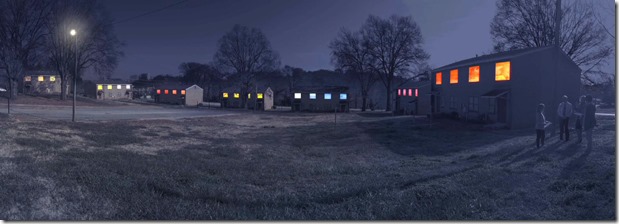Artist shares designs that will show Spartanburg ‘in a new light’

From the Spartanburg Herald Journal
Article by Alyssa Mulliger
Illuminated smokestacks, colorful suspended mobiles and floating light islands are a few of the special installations coming to 10 city neighborhoods as part of the Seeing Spartanburg in a New Light initiative.
Spartanburg and three other cities were selected out of 230 applicants nationwide to receive up to $1 million to develop light installations for the temporary art project supported by the Bloomberg Philanthropies Public Art Challenge.
Over the past few months, Ohio-based artist Erwin Redl has worked with community members and neighborhood associations in Andrews Farm, Beaumont Village, Converse Heights, Downtown Spartanburg, Forest Park, Hampton Heights, Highland, Maxwell Hills/Duncan Park, Northside and South Converse to design and develop the LED light installations.
“You have to engage (the community) to make it meaningful to them,” Redl said. “We had to find compromise and take (their) input not as a critique, but as an inspiration. With this grant, we have the opportunity to basically alter the landscape of Spartanburg.”
Redl presented the design concepts Monday night to Spartanburg City Council, which gave its final approval.
All projects will be completed by Oct. 4, 2016, when the lights will be lit in conjunction with National Night Out.
In the Northside and Beaumont Village, Redl has plans to illuminate the old Spartan Mills smokestack at the Edward Via College of Osteopathic Medicine and the one at the former Beaumont Mill.
The structures will be covered in a checkerboard pattern of blue and white fabric attached at the top of each smokestack. On the ground, programmable LED flood lights will light the smokestacks with different color sequences at night. The fabric will reflect light better than the brick on the smokestacks, Redl said.
While some of the projects are self-contained, like the smokestacks, Redl said others will be more neighborhood-based.
In the Highland neighborhood, residents will help create a “video village” by filming short clips that will be projected onto second-story windows of vacant housing structures. The installation will involve more than 50 synchronized screens that will put life back into the buildings, Redl said.
Other neighborhood installations include transparent color swatches assembled into large-scale mobiles and suspended above a downtown lot; a light bench with multiple, individually programmable light panels placed near C.C. Woodson Recreation Center in Forest Park; a kinetic light installation with 26 pendulums mounted behind the north side of the National Beta headquarters in Hampton Heights; eight floating light islands in the center of Duncan Park Lake; colored LED lights attached to the underside of the picnic shelter at the north entrance of South Converse Street Park; and a joint project with Andrews Farm and Converse Heights involving LED signs with scrolling poetry suspended over Lawson’s Fork Creek on the Cottonwood Trail.
Jennifer Evins, president and CEO of Chapman Cultural Center, said the lights will stay lit from six months to six years, depending on the installation.
“It will be transformative as a light art project, but it’s also the process of relationships that we’ve built,” she said. “It’s using art as a catalyst to address important issues that are facing the city.”
Several of the city’s police officers were part of the selection committee that chose the installation sites. Spartanburg Police Chief Alonzo Thompson said the light projects will help transform the city to enhance its livability and vitality.
“This is a proactive, positive collaboration with the police and the community overall with these pieces of art that are going to be symbolic of our commitment to our city and to each other,” Thompson said. “We want people to come and live in our city, visit our city and we think you’ll like what you see once we show it to you in a new light.”
Image: Artist rendition of Video Village, one of nine art projects that are part of Seeing Spartanburg in a New Light, funded by Bloomberg Philanthropies.

